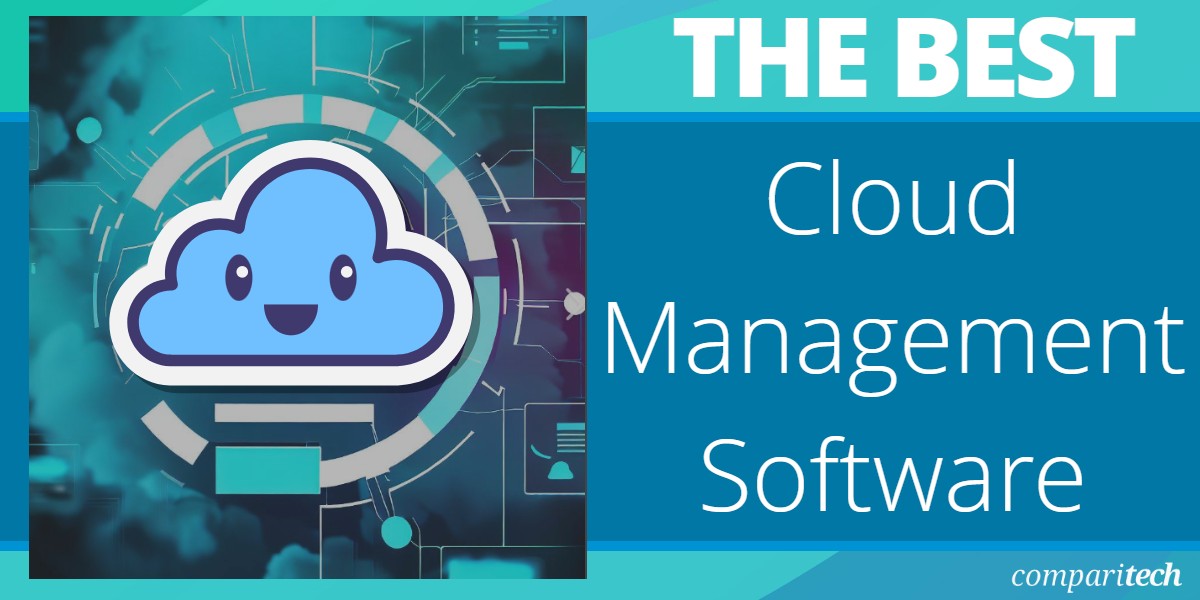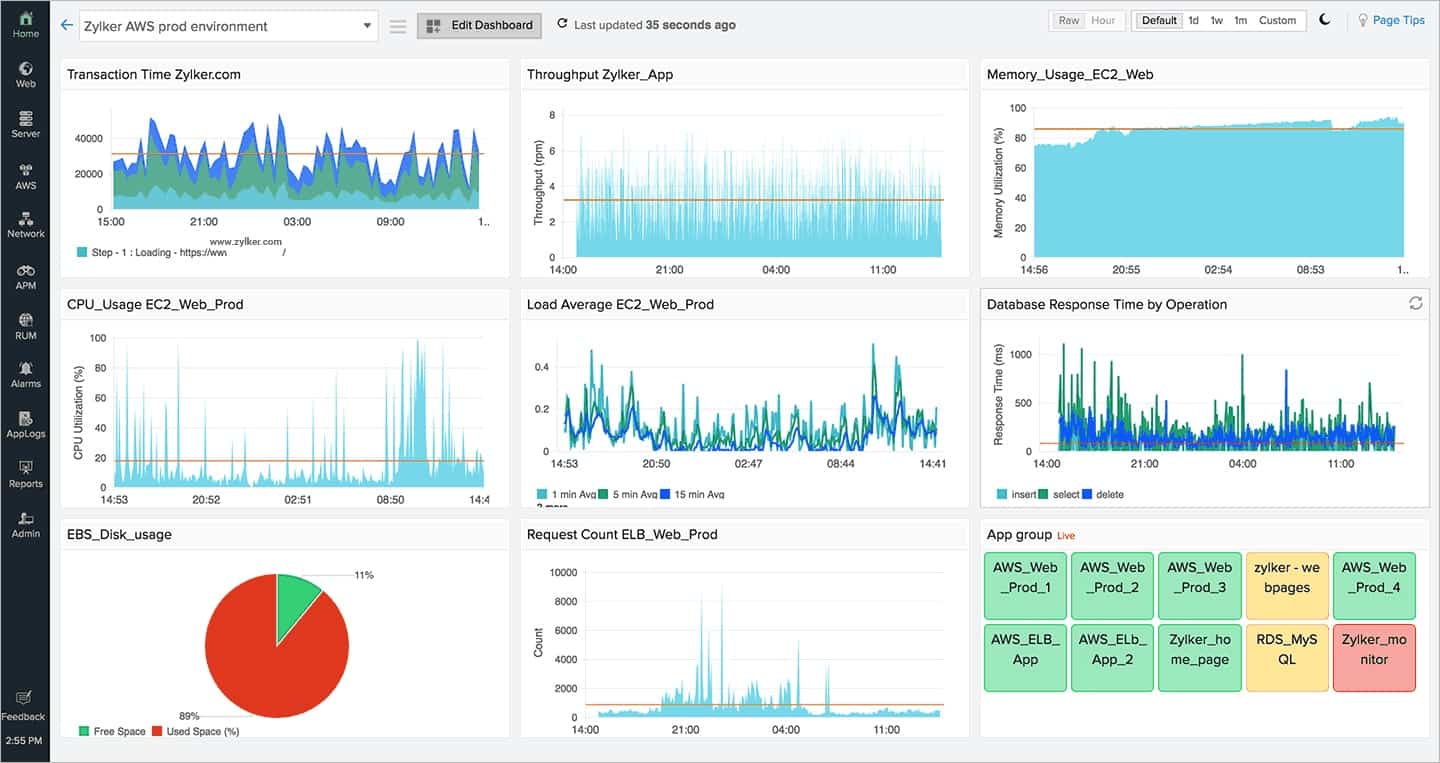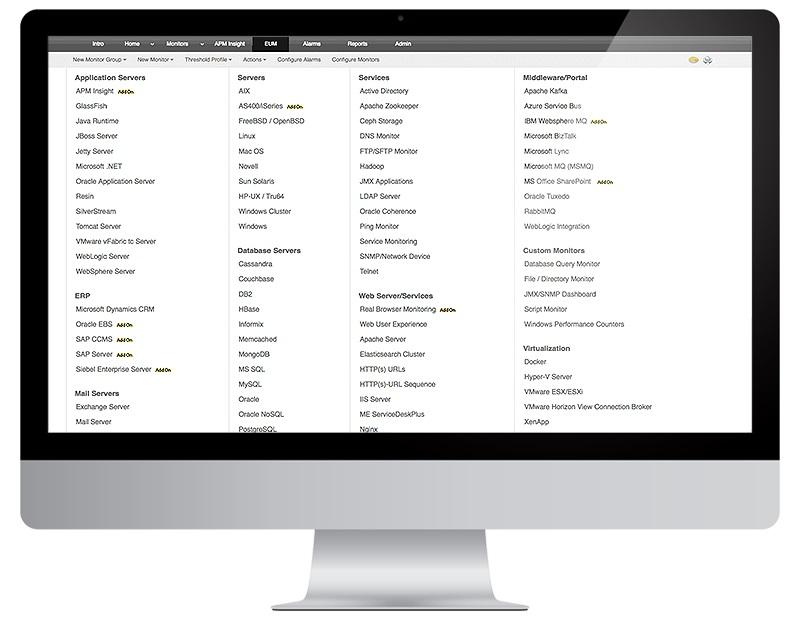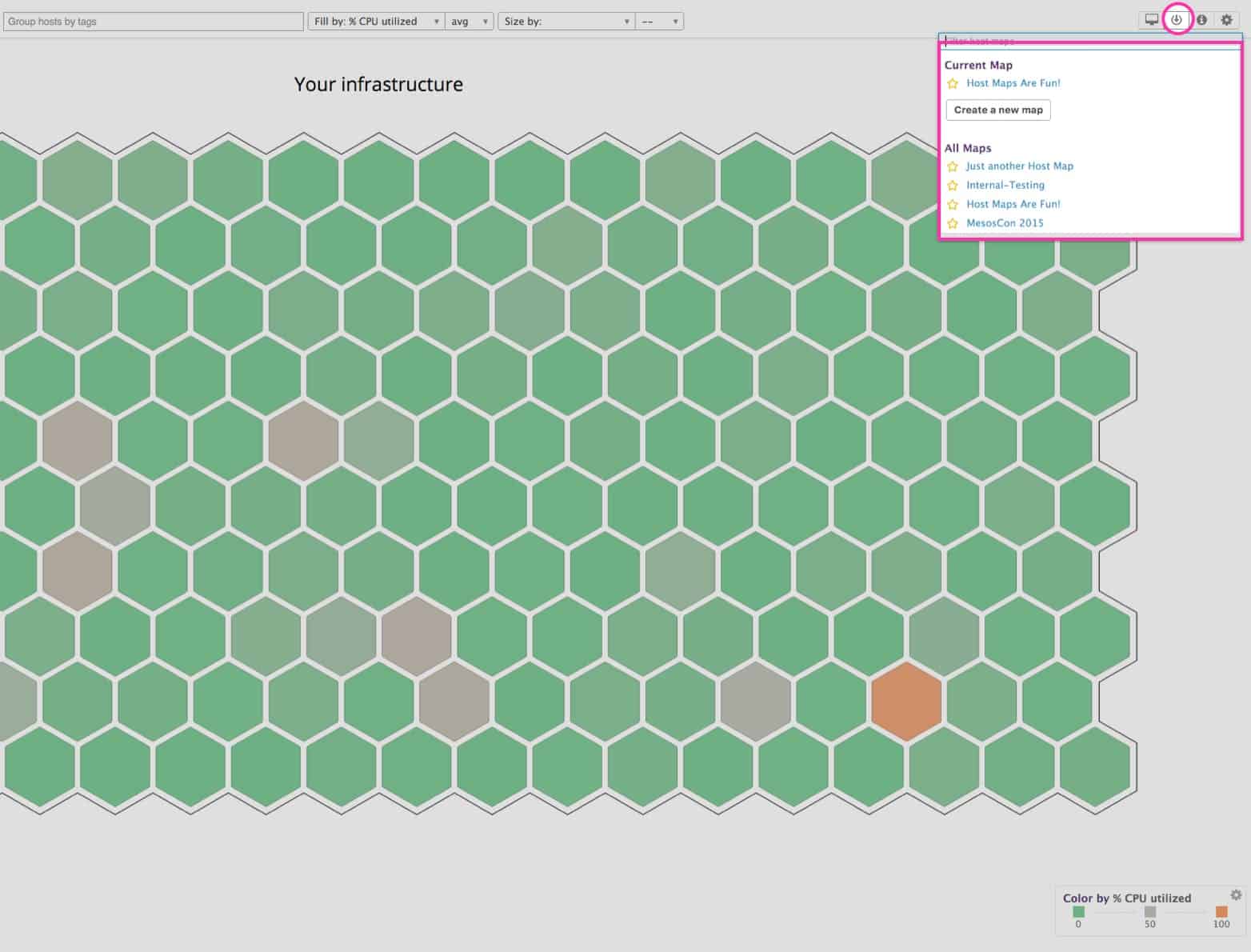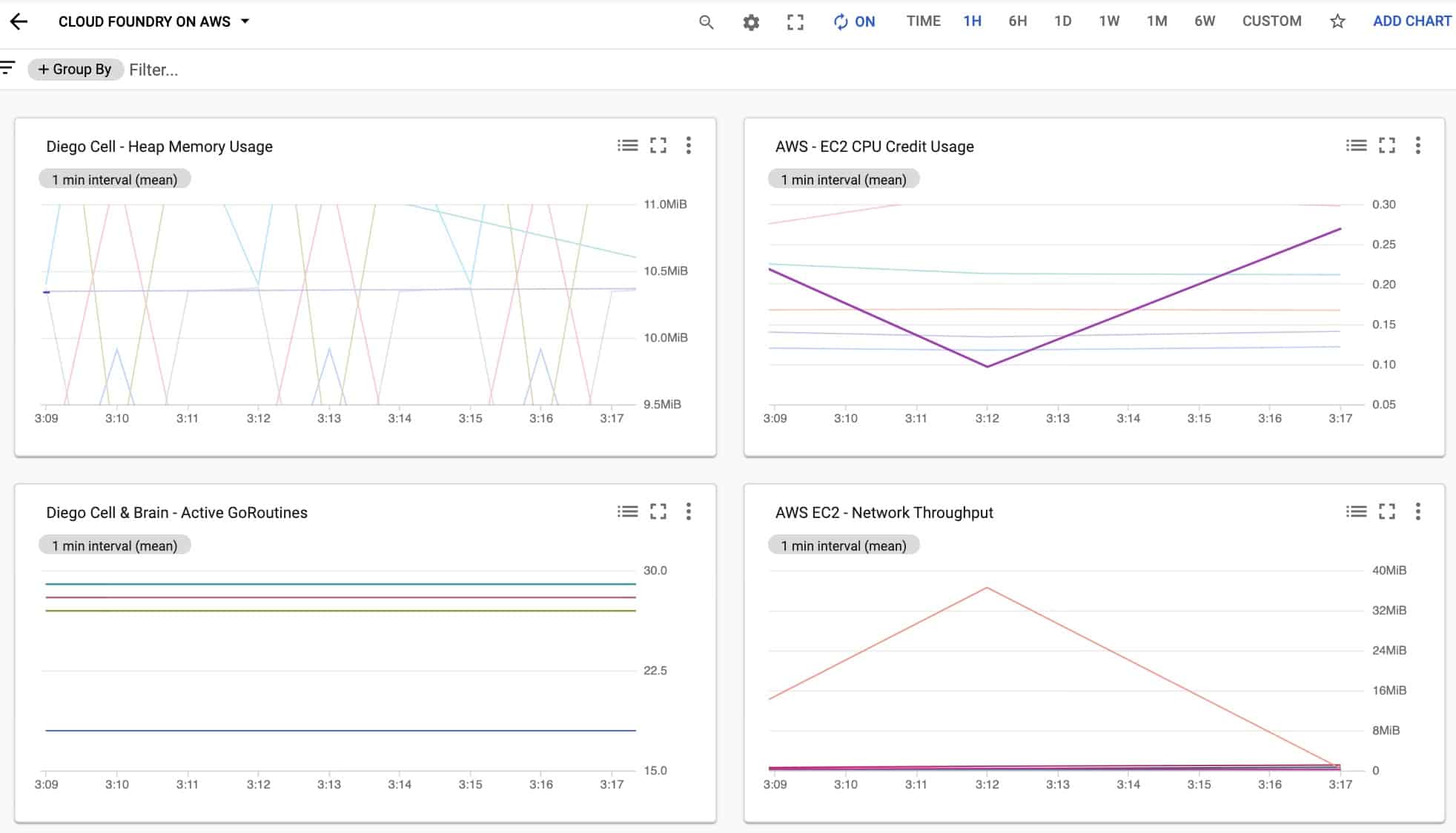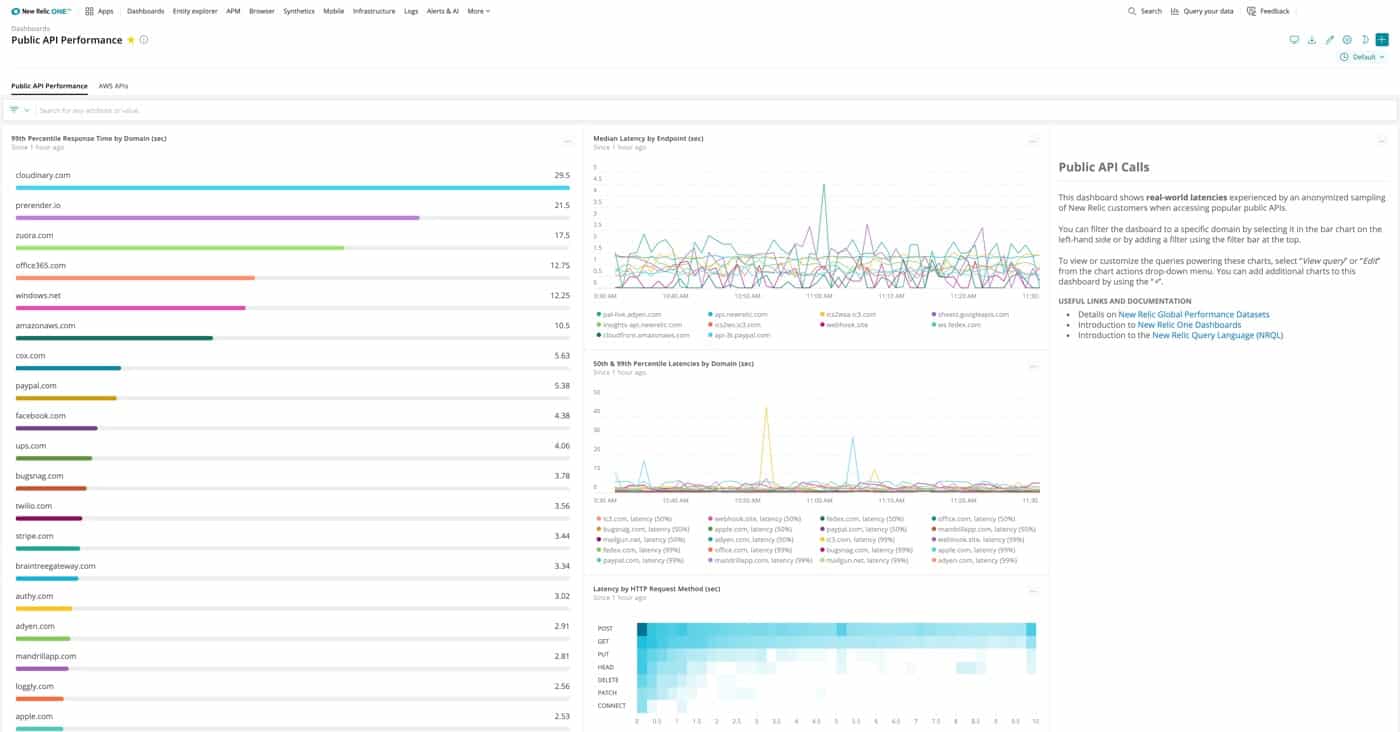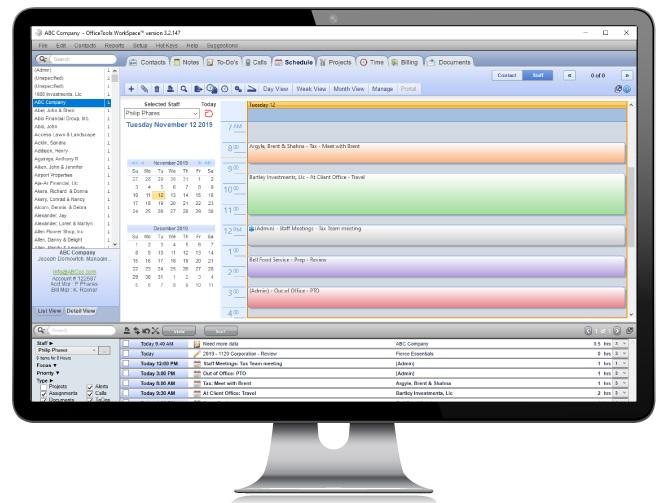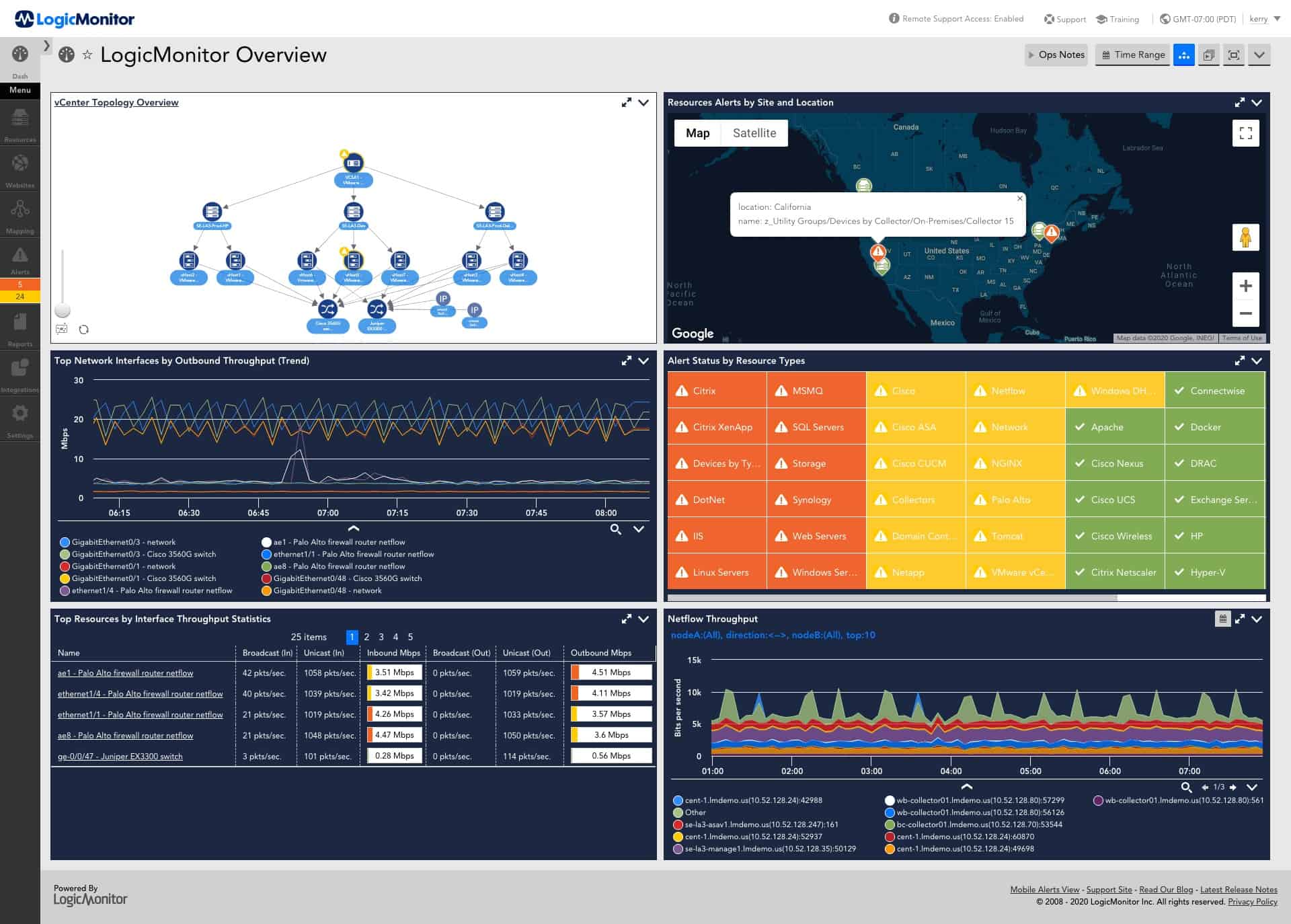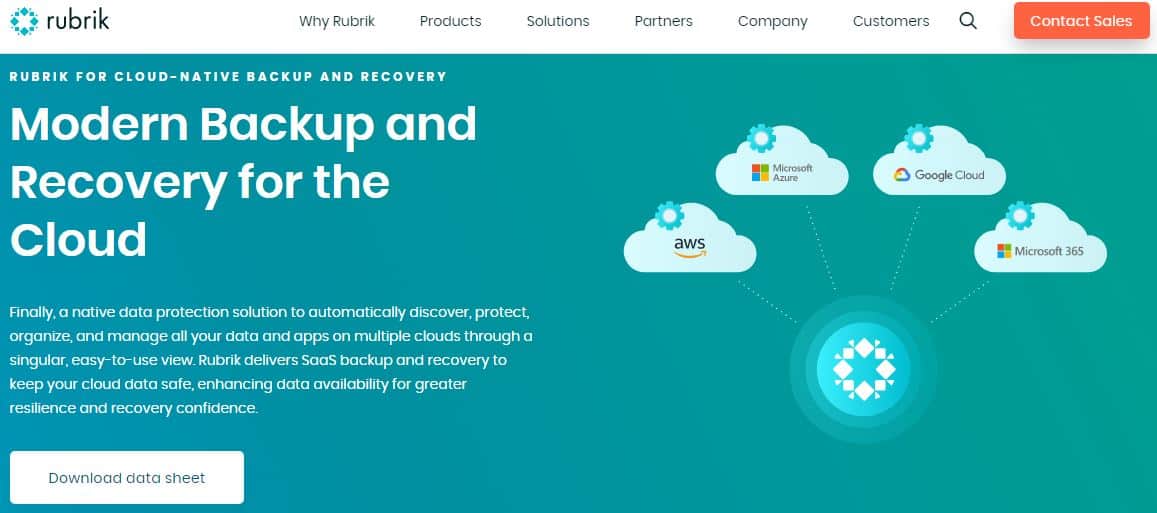Cloud management software is a digital solution that organizations use to monitor and control their cloud computing assets.
Meanwhile, cloud management involves monitoring and tracking private, public, hybrid, and multi-cloud deployments for issues or bottlenecks and resolving them with the least possible downtime or interruption possible.
There is no need for spending on tech teams and hardware – all the critical issues are analyzed and presented in a way that allows for immediate actions to be taken care of by a single admin located anywhere in the world.
Here is our list of the best cloud management software:
- Site24x7 Cloud Monitoring EDITOR’S CHOICE The choice for businesses looking to monitor their assets on the three major platforms: AWS, Azure, and GCP; covers a large number of technologies with over 100 plugin integrations. Start a 30-day free trial.
- ManageEngine Log360 Cloud (FREE TRIAL) This SaaS package provides log management and security scanning for on-premises and cloud systems with compliance management built in. Start a 30-day free trial.
- ManageEngine Applications Manager (FREE TRIAL) Great solution for businesses looking to keep track of their data storage technology and how they may affect their applications or processes that are dependent on them. Start a 30-day free trial.
- Datadog Cloud Monitoring Cloud monitoring solution that presents assets in highly informative maps; it can integrate with numerous other of its software and hardware monitoring tools which extend its capabilities by far.
- Google Cloud Platform World-class cloud platform with a proven track record; easy to set up, uses an agentless data collector that works with a wide range of systems.
- Splunk Enterprise Heavy-duty cloud monitoring tool for mining data from IT infrastructures, systems, and applications; it is customizable to meet specific log or machine data analysis requirements.
- Loggly Cloud tool for monitoring logs and events – from any software or hardware source – to find anomalies in any architecture.
- New Relic Highly scalable, full-stack monitoring that tracks all operational data and shows it in one view; it works with any machine data and correlates it using machine learning analysis for better observability.
- Abacus Private Cloud Platform for businesses looking for a private cloud to move their whole technology infrastructure into; additional features make it ideal for legal and accounting firms, as well as other SMBs
- LogicMonitor SaaS-based performance monitoring platform for Enterprise IT; automatically discovers connected and immediately starts capturing their machine data making it the best choice for architectures that are continuously growing.
- Rubrik Cloud-native backup tool that helps businesses get back up and running in a short time; it also prevents data loss and can integrate with other tools for enhanced cloud management capabilities
The Best Cloud Management Software
Cloud management software solutions are used for various administrative tasks including monitoring platforms, architectures, applications, productivity software suites, hardware, as well as handling security and backups.
Our methodology for selecting a cloud management software system
We reviewed the market for cloud management services and analyzed the options based on the following criteria:
- Coverage for AWS, Azure, and Google Cloud Platform
- Application and service dependency discovery and mapping
- Live performance data represented in graphs
- Alerts for performance problems
- Activity logging and log management
- A free trial or demo system for a no-cost assessment opportunity
- Value for money from a comprehensive tool that is offered at a fair price
Using this set of criteria, we looked for cloud management systems that automate performance monitoring, saving time and money.
1. Site24x7 Cloud Monitoring (FREE TRIAL)
Site24x7 Cloud Monitoring offers insights into the health and performance of cloud services and applications hosted in the three major platforms: Amazon Web Services (AWS), Microsoft Azure, and Google Cloud Platform (GCP).
Key Features:
- Triple-Platform Support: Monitors AWS, Azure, and GCP for comprehensive cloud oversight.
- Extensive Plugin Library: Enhances functionality with over 100 available plugins.
- Deep Dive Diagnostics: Enables detailed system and code-level issue investigation.
Why do we recommend it?
Site24x7 Cloud Monitoring uses a range of techniques to check on the availability and performance of your Azure, AWS, and GCP accounts. The tools in the pack range from a Ping availability monitor, which can also be applied to the systems that you host on the cloud, through to AI-based interpolation system to predict service capacity.
This is a centralized approach to monitoring entire cloud infrastructures – be they in the cloud or in a virtualized data center. In the case of AWS, for example, admins can analyze the performance of native services like EC2, EBS, and optimize usage of CloudWatch.
Highly configurable dashboards allow for easy tracking of the performance of IaaS services – including virtual machines (VMs) and Kubernetes – as well as PaaS services like App Service or Event Hubs.
With Site24x7’s exclusive VM extensions admins get system-level metrics like CPU, memory, storage, and network usage for all Windows and Linux virtual machines as well as application performance management for .NET applications.
With the metrics captured, they can drill down into transactions to get critical, code-level insights allowing them to debug performance issues for distributed applications in AWS. They can also monitor GCP services like Google Compute Engine (GCE), Google App Engine (GAE), Google Kubernetes Engine, and more – and see the availability of the entire GCP stack from one console.
What’s more, there are over 100 plugin Integrations – including MongoDB, Apache, Nagios, RabbitMQ, and much more – for even more monitoring capabilities.
Meanwhile, should issues need to be escalated, Site24x7’s chatbot integration with Microsoft Teams allows for a collaborative effort to address them in a timely manner.
Who is it recommended for?
The Site24x7 system is suitable for businesses of all sizes. The company sells plans that include all of the modules on the platform rather than individual services. So, you get network, server, and application monitoring as well as the cloud monitoring service. This system is particularly appealing to small businesses.
Pros:
- Hybrid Environment Versatility: Seamlessly integrates with cloud and hybrid environments, including AWS, Azure, and GCP.
- Rich Monitoring Suite: Boasts an expansive array of over 100 monitoring tools for infrastructure and applications.
- Application Stack Visibility: Provides insight into application dependencies, aiding SLA compliance and uptime optimization.
- AI-Driven Troubleshooting: Utilizes AI for quick identification and resolution of technical issues.
Cons:
- Complexity: The platform’s wealth of features and options may necessitate a learning curve to fully leverage its capabilities.
You can find a 30-day free trial.
EDITOR'S CHOICE
Site24x7 Cloud Monitoring is our top pick for a cloud management system because this package provides monitoring for cloud platforms and also log management – which can provide further insights into cloud platform performance. This system is marketed in packages that include full-stack observability. Plans also include website monitoring tools and network configuration management. This is a good choice for businesses of all sizes. Site24x7 sizes and prices its plans to suit small businesses but the platform also caters to some very large organizations. The company provides service expansion packs that enable businesses to adjust each element to provide more emphasis on specific areas, such as cloud monitoring.
Download: Start a 30-day FREE Trial
Official Site: https://www.site24x7.com/signup.html?pack=44&l=en
OS: Cloud-based
Related post: Site24x7 Monitoring Software Review
2. ManageEngine Log360 Cloud (FREE TRIAL)
ManageEngine Log360 Cloud is a large package of security tools that also provide cloud account management functions. The core of this package is a SIEM, which mines log data for signs of security breaches. However, that collection of data provides opportunities for many other activity analysis functions.
Key Features:
- Access Control: Manages employee access to cloud platforms effectively.
- Unauthorized Activity Blocking: Prevents the use of unapproved sites and applications.
- Usage Monitoring: Tracks employee engagement with cloud services for optimization.
Why do we recommend it?
ManageEngine Log360 Cloud is based in the cloud but can collect log messages from your on-premises systems and cloud services, but only those on the AWS platform. This is a SIEM service and also provides data loss prevention. The tool can be used for a range of security investigations, including insider threat detection.
Cloud usage statistics per employee can be used to identify which SaaS packages are worth the money and which turned out to be unnecessary. The usage tracking can also be used for user activity profiling, which is an essential baseline for anomaly detection. Sudden changes in activity can indicate an insider threat or an account takeover.
The ManageEngine system doesn’t just monitor cloud accounts. It also gathers logs from your on-premises system, which includes network devices as well as endpoints. This enables you to enforce security policies everywhere in your organization.
The Log360 system is able to coordinate with third-party systems, such as access rights managers and firewalls – these can be on-premises or in the cloud. With this cooperation, the Log360 system is able to implement locks on suspicious IP addresses and user accounts.
Incidents can be dealt with automatically but they are also reported by notifications to your technical team. These can be channeled through your Service Desk ticketing system. It is also possible to send additional notifications by email outside of the IT department, such as to a finance department security operative.
So, the Log360 system can be used for system access management, service assessments, planning, security, and compliance.
Who is it recommended for?
If you have Azure or GCP accounts, you can set up a log forwarder to include them in the Log360 system. The package also provides a CASB, which tracks user activity from your endpoints to cloud services. There is a Free edition for small businesses. Two paid plans suit mid-sized and large businesses and there is also an MSP version.
Pros:
- Comprehensive Security: Offers robust protection and surveillance for both cloud and on-premises infrastructure.
- Cloud Service Valuation: Assesses the financial efficiency of utilized SaaS offerings.
- Regulatory Compliance: Facilitates adherence to major standards like PCI DSS, HIPAA, and ISO 27001.
- Integrated Security Management: Ensures security across the organization through log analysis and policy enforcement.
Cons:
- Limited Cloud Scope: Primarily supports AWS, restricting direct monitoring capabilities for Azure and GCP environments.
The ManageEngine Log360 Cloud is entirely resident in the cloud and you can assess it with a 15-day free trial.
3. ManageEngine Applications Manager (FREE TRIAL)
ManageEngine Applications Manager monitors IT connectivity infrastructure, data storages, and applications for visibility into assets – regardless of their location: on-premises or cloud-native.
Key Features:
- Hybrid Compatibility: Seamlessly integrates with both cloud and on-premise technologies.
- Broad Technology Support: Addresses issues across over 100 technologies, focusing on optimal performance.
- Database Optimization: Specializes in enhancing database performance across a diverse range of storage products.
Why do we recommend it?
ManageEngine Applications Manager tracks the activity of software and the servers that it runs on. So, it will watch over applications, services, and server resources. The server monitoring section includes cloud platform monitoring. The tool looks at all processes running on a platform and then crawls through them to create an application dependency map.
Applications Manager supports a wide range (over 100) of popular technologies for servers, VMs, cloud applications, containers, databases, big data stores, middleware, messaging components, web services, and ERP suites. It even monitors custom, in-house applications – admins simply create custom scripts to facilitate two-way communication.
While this cloud management software can scale up to monitor 10,000 applications it can also give comprehensive insights into databases without the need of installing anything. This agentless tool can track slow-executing queries, resource-intensive statements, delayed response times, failures, and site faults, to name a few issues.
It can also easily identify, and help solve, database issues that impact the performance of applications that use them. Admins can work with a wide array of databases as Application Manager offers out-of-the-box support for:
- JDBC databases – Oracle, MS SQL, MySQL, etc.
- NoSQL technologies – Oracle NoSQL, MongoDB, Apache HBase, etc.
- Big data stores – Hadoop
- In-memory databases – SAP HANA, Oracle Coherence, Redis.
This helps businesses proactively troubleshoot application server issues before they can affect the overall performance of their business processes.
Who is it recommended for?
ManageEngine offers a Free edition of Applications Manager but it is limited to monitoring five assets. This isn’t much so most businesses will need to look into the paid versions. Prices scale up according to the required capacity and that makes the paid packages accessible to all businesses.
Pros:
- Versatile Deployment: Supports both on-premises and cloud environments, offering flexible installation choices.
- Application Interconnectivity Insight: Reveals the interplay between applications to pinpoint potential performance bottlenecks.
- Comprehensive Monitoring: Includes memory usage, disk IO, and cache status in its log monitoring for a complete health overview.
- Automatic Discovery: Effortlessly identifies databases, server hardware, and devices for streamlined asset management.
Cons:
- Learning Curve: The platform’s extensive features and capabilities may require time to master fully.
Download a 30-day free trial of Applications Manager here.
4. Datadog Cloud Monitoring
Datadog is a popular platform for cloud monitoring, security, and analytics. It is preferred across the board by developers, IT operations teams, security engineers, and even business users.
Key Features:
- Comprehensive Network Insight: Provides full visibility into cloud network structures.
- Actionable Log Visuals: Delivers log data in graphical formats for clear, actionable insights.
- Log Management: Features include archiving and alerts for exceeded log thresholds.
Why do we recommend it?
Datadog Cloud Monitoring is part of a very large platform of system monitoring, management, and security services. Datadog has many modules that provide cloud monitoring services. These include Log Management, Serverless Monitoring, APM, and its synthetic and real user Web application monitoring tools. The core module for cloud platform monitoring is the Infrastructure unit.
Datadog Cloud Monitoring is a SaaS-based management tool for cloud-scale logs, applications, infrastructures, and more. It is, in fact, the ideal choice for monitoring hybrid environments.
It gives in-depth visibility into the full stack – and across dynamic or high-scale architectures – by sifting through events, logs, and metrics. It can give insights into over 500 environments. This is a tool with up-to-date monitoring capabilities and security that lets admins see inside any stack, any app, at any scale, and located anywhere.
Datadog’s dashboard helps admins keep an eye on incidents occurring anywhere in the stacks – host and container maps make it easier to monitor statuses of servers, for example – and allow for serverless functions for monitoring, analyzing, and filtering.
The already highly informative maps can be saved for later retrieval and are easy to “slice and dice” for further in-depth analysis.
Apart from giving insights, it can integrate with Datadog’s numerous other products which can then monitor, troubleshoot, and optimize the data source applications or devices which could also be running on any infrastructure.
Who is it recommended for?
One problem with the Datadog solution to cloud monitoring is that there are many modules that include cloud monitoring facilities. Small businesses that don’t have the budget to pay for the full stack of cloud monitoring systems should start with the Infrastructure Monitoring tool. After that, the type of business will dictate which of the other units are needed.
Pros:
- Broad Monitoring Scope: Ideal for overseeing cloud and hybrid environments, covering over 500 technologies.
- Intuitive Interface: Boasts a user-friendly, customizable dashboard for ease of monitoring.
- Holistic Network Monitoring: Enables complete network performance and accessibility views, both internally and externally.
- Scalable Monitoring Solutions: Offers flexible pricing, making it accessible for businesses of any size to scale their monitoring efforts.
Cons:
- Trial Limitations: A longer trial period is desired for a comprehensive evaluation of its features.
You can give Datadog Cloud Monitoring a spin; a free trial is available here.
5. Google Cloud Platform
Ok, we will be switching gears with Google Cloud Platform because, when compared to the other cloud management solutions, this is the “industrial” version of a cloud management tool.
Key Features:
- User-Friendly Setup: Simplifies initiation and usage, complemented by comprehensive support documentation.
- Broad OS Integration: Compatible with various Linux distributions and Windows Server editions.
- Advanced AI Tools: Features a robust selection of AI and data analysis applications.
Why do we recommend it?
If you have an account on Google Cloud Platform, you get access to a dashboard to manage your virtual servers, storage space, and services. This dashboard also provides performance reporting, which gives live information on a range of factors, including accumulating costs.
Google Cloud Platform has an API that is dedicated to Cloud Monitoring which collects metrics, events, and metadata from other Google Cloud architectures, Amazon Web Services (AWS) or other cloud platforms, hosted uptime probes, and application instrumentation.
As a matter of fact, it is an IaaS solution that has numerous tools under one roof that can be used to do everything from creating simple websites to running complex applications. It is a world-class solution that works with other cloud services and would especially appeal to fans of Google Services.
The tool gives insight into the full stack and allows for the presentation of its metrics in real-time; this makes it easy to track, analyze, and resolve issues fast.
There is no installation involved; an agentless data collector works to collect data within the architecture without burdening it or eating up supplemental resources.
Google Cloud Platform is easy to set up and can collect data from over 150 common application components, on-premises systems, and hybrid cloud systems and presents insights via dashboards, charts, and alerts.
Who is it recommended for?
The monitoring console in GCP is called Active Assistb and it can be expanded by different add-ons to monitor more systems in deeper ways. Some of these extras a free and some of them are paid tools. The menu of options is very long and each business will need to scan through the options.
Pros:
- Seamless Cloud Integration: Ideal for those accustomed to Google Cloud services, offering straightforward usability.
- Rich Documentation and APIs: Provides extensive support materials and API integration for enhanced functionality.
- Extensive Monitoring Capabilities: Supports cloud monitoring, management, and deployment with over 150 metrics.
Cons:
- Self-Service Model: Prefers detailed documentation over direct live support, which may not suit all users.
Google Cloud Platform offers a Free Trial here.
6. Splunk Enterprise
Splunk Enterprise is a heavy-duty cloud monitoring tool that analyzes data for use in security, IT, and DevOps.
It makes it easy to mine, analyze, and act upon the big data generated by technology infrastructures, security systems, and business applications. Armed with this insight, admins can optimize processes to achieve better business performance.
Key Features:
- Versatile Solutions: Offers tailored solutions for IT, security, IoT, and business operations.
- Highly Customizable: Adapts to specific user needs for handling vast data volumes.
- Report Flexibility: Enables the export and sharing of reports in multiple formats.
Why do we recommend it?
Splunk Enterprise is the on-premises version of the Splunk data processing system. The cloud version is called Splunk Cloud and both versions can collect data from cloud platforms and on-premises systems – the only difference is where the Splunk software is hosted. You can use this tool to collect and analyze any type of data.
The tool is ideal for international businesses that want to leverage their infrastructure – with the help of real-time metrics data – and achieve optimal performance through it. The data is displayed for analysis and further breakdown in dashboards that make it easy to spot and prevent issues – both in the present and future – with accurately informed actions.
Splunk can collect and index log and machine data from any source. It can even combine machine data with data stored in relational databases, data warehouses, and Hadoop or NoSQL data stores. With multi-site clustering and auto load-balancing, it can be scaled to process terabytes of data.
Perhaps a unique angle with Splunk is that the platform makes it easy to customize Splunk Enterprise to meet clients’ needs. Depending on their projects, developers can build custom Splunk applications or integrate Splunk data into their applications.
Admins can create custom dashboards to view the data in a comprehensible format. They can use a wide range of charts and visual presentations to tell a data story that is directly actionable.
Extracted reports – which are created in real-time or scheduled to run at intervals – can be saved or shared securely.
Who is it recommended for?
Splunk Enterprise lets you create your own data analysis systems and Splunk also offers a menu of pre-written performance and security monitoring packages. This list of systems includes a SIEM that can include data from cloud platforms as well as your on-premises resources. It can also gather data from IoT and industrial equipment.
Pros:
- Comprehensive Data Visualization: Utilizes engaging visuals for effective data presentation and insights.
- Broad Data Collection: Compatible with numerous environments for extensive data gathering.
- Intelligent Monitoring: Employs machine learning for enhanced source identification and behavior tracking.
- Enterprise-Level Support: Provides robust support and a plethora of integration options for large organizations.
Cons:
- Enterprise Focus: Primarily designed for the complex needs of large enterprise networks, which may be overwhelming for smaller entities.
You can find your free download of Splunk Enterprise here.
7. Loggly
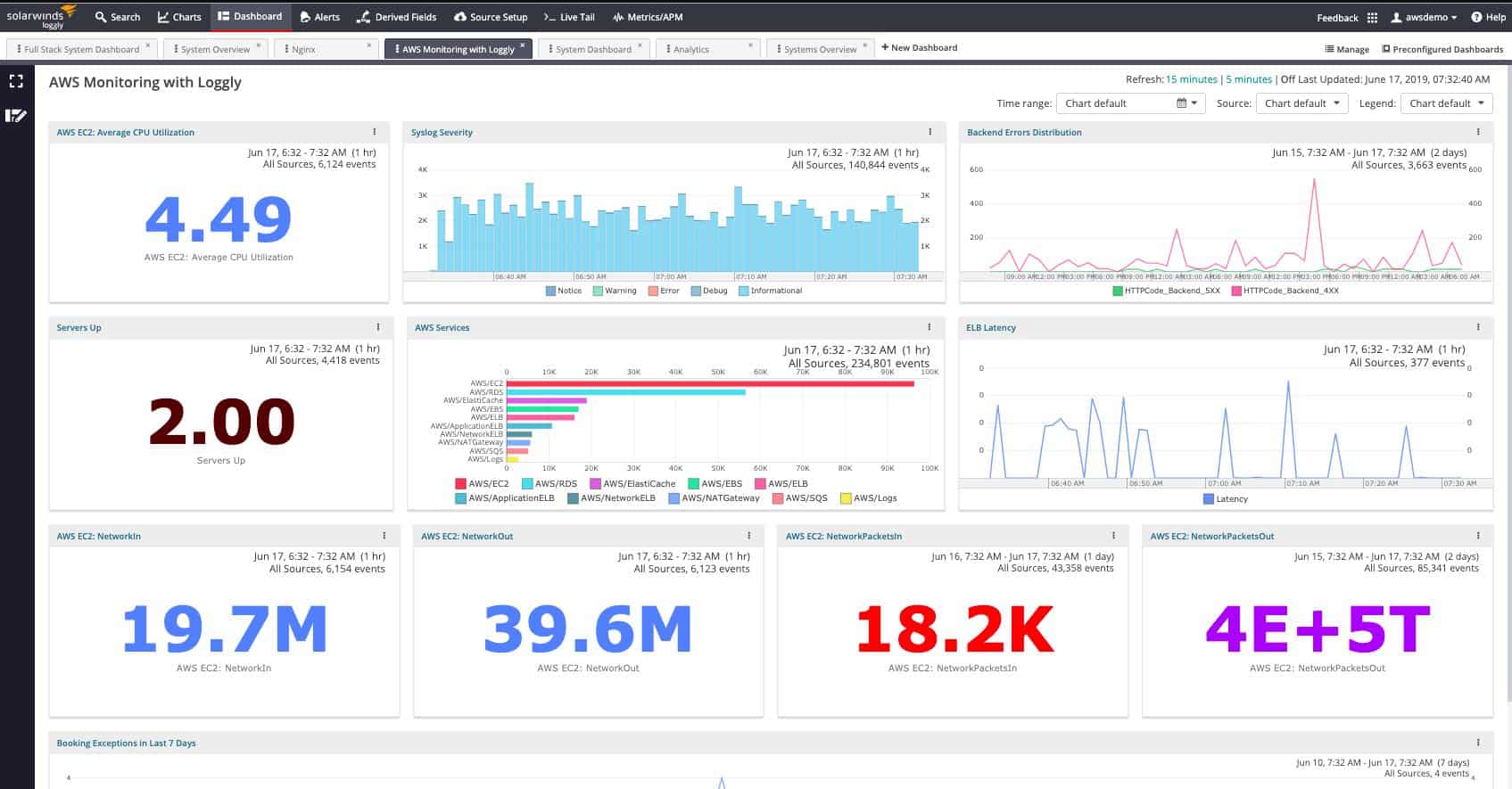
Loggly by SolarWinds is an efficient and easy-to-use cloud monitoring tool for centralized log analysis and monitoring, which helps in resolving performance issues faster.
Key Features:
- Cloud-Wide Analysis: Simplifies the process of log and event analysis across all cloud environments.
- Zero Installation: Begins monitoring by redirecting logs to the cloud without any installation.
- Versatile Compatibility: Supports various environments including on-premises, private, and public clouds.
Why do we recommend it?
SolarWinds Loggly is a log management system and it can collect log messages from cloud platforms as well as from your on-premises assets. The system can take logs from Amazon CloudWatch and directly from some AWS products. It also has a collector for the Heroku platform.
This can be classified as a “log management as a service” solution because no installation is required; all the client needs to do is redirect its logs from its applications and infrastructure to Loggly – which is hosted on AWS.
It doesn’t matter how many devices there are, the users can create as many dumps as they want from sources like operating systems, servers, applications, connectivity devices. They can even export logs from end-user devices or their browsers – Loggly doesn’t care about the log format; it will analyze any log file thrown its way.
Once the data has been collected, it immediately becomes ready for rendering into reports.
Analysis results are also represented as graphs that can then be used to compare data types across timelines. Admins can easily extract any specific data they want to compare or analyze because Loggly also becomes a real-time search engine for the captured data.
In fact, the tool has search capabilities allowing for text searches to be saved for future retrieval or serve as a framework for designing custom dashboards. Also, if any search conditions are met they can be converted into triggers for alerts.
This tool is ideal for businesses looking to build in the cloud using Infrastructure as a Service (IaaS) platforms like AWS, Azure, and GCP – or hybrid architectures involving any combination of on-premises and private or public cloud services.
Who is it recommended for?
Log messages for the basis of many system monitoring services. They are generated automatically by operating systems, cloud platforms, and software packages. This system can update your AWS service settings to forward logs to the Loggly server. In the case of Azure and GCP, you would have to set up a log forwarder on the platform.
Pros:
- Cloud-Native Scalability: Effortlessly scales with your infrastructure in the cloud, eliminating physical server constraints.
- Streamlined Setup: Quick and straightforward initiation without a complex installation process.
- Comprehensive Log Collection: Capable of integrating logs from a variety of sources including AWS and Docker.
Cons:
- Trial Duration: A more extended trial period, such as 30 days, would be beneficial for a thorough evaluation.
It is a highly scalable tool that can work on any network size as you will see when you try Loggly for free here.
8. New Relic
New Relic is, arguably, the largest and most comprehensive cloud-based monitoring platform created to help customers build better software. It is one of the most popular solutions in the world’s best DevOps and software developer teams.
Key Features:
- Advanced AI Integration: Enhances performance efficiency without compromising speed.
- Deep Code Insights: Identifies and resolves coding issues to eliminate bottlenecks.
- Optimization for Development: Tailored for software teams to maximize digital assets.
Why do we recommend it?
New Relic is an ever-expanding cloud platform of system monitoring tools. New Relic invented the application performance monitor but now offers full stack observability. There are seventeen units on the platform and you can’t just subscribe to one of them, which means that you might end up paying for services that you don’t need.
They use New Relic to monitor and optimize their technology stack – top to bottom – and everything from infrastructure and applications to browsers and mobile apps.
It is platform-independent, easy to deploy, and requires no hardware management – the perfect combination for higher ROI and lower TCO.
Aesthetic and informative dashboards deliver immediate, real-time insights into supporting services, data stores, and hosts. They can also monitor infrastructures, cloud resources, containers, and clusters. Simply put: it offers full visibility and analysis of full stacks from a single point.
Admins can monitor distributed services, applications, and serverless functions, regardless of where they’re developed. It spots issues using in-depth transaction details that list the exact method calls – down to the code’s line number.
Distributed tracing helps trace the path of a single request from end to end – even when the system is complex. Admins can track the entire chain through every service and dependency, all the way through to the database, and know which step in the path is creating a bottleneck or causing an error.
Add to this that it can work with several app languages, operating systems, and platforms including – but not limited to – Java, .NET Framework, Python, Kubernetes, Google Cloud, Azure, AWS, and much more, and it becomes evident that this is indeed a powerful cloud monitoring tool.
Who is it recommended for?
This is a solution that is suitable for large companies and particularly those that run or use Web applications or SaaS platforms. This is because there are a lot of serverless monitoring features in the package and you have to pay for that whether you use it or not.
Pros:
- Extensive Integration Capabilities: Supports a broad spectrum of environments and platforms for comprehensive monitoring.
- Azure Certified Monitoring: Officially recognized for effective Azure environment oversight.
- Anomaly Detection: Employs advanced techniques to detect and alert on unusual system behaviors.
- User-Friendly Dashboards: Provides clear, real-time insights through straightforward administrative panels.
Cons:
- Primarily for Larger Deployments: Best suited for substantial cloud operations, potentially limiting its appeal for smaller setups.
Admins can monitor their full-stack for FREE and with full platform access, plus 100GB of ingest per month.
9. Abacus Private Cloud
When it comes to Abacus Private Cloud from AbacusNext, users of the hosting service need to make a paradigm shift on how they go about accessing, storing, and processing data. Everything they need to work on is accessed from their private cloud and means they don’t need to worry about hacks and breaches, especially from inexperienced admins slipping up.
Key Features:
- Unified Virtual Desktop: Delivers all applications and systems through a singular virtual interface.
- Productivity Suite: Offers a wide array of office tools to enhance business efficiency.
- SMB-Friendly: Ideal for accounting, legal firms, and other small to medium-sized businesses transitioning to the cloud.
Why do we recommend it?
Abacus Private Cloud is a virtual server. So, its services aren’t split up into separate accounts as they would be with AWS, Azure, or GCP. You don’t have to worry about getting a particular type of service for a particular type of processing and a particular type of storage. Instead, you just treat this server in the same way as one on your own site.
The platform is designed to host and manage a business’ mission-critical applications and data. This is then made available in virtual workspaces that are accessible from anywhere in the world, using connected devices.
Abacus Private Cloud creates a virtual desktop and server hosting for a business’ entire IT environment. By moving fully into the cloud, a business can continue to operate around the clock, from one central location that is accessible to its employees around the world.
Apart from cutting hardware, overhead, and IT expert expenditures, Abacus Private Cloud also keeps data safe with security features like 256-bit AES data encryption, multi-factor authentication, and automated backups.
Also, apart from their own applications or enterprise software solutions, businesses can enjoy several applications like Office Tools, Results CRM, and Cloudnine Realtime – all AbacusNext acquisitions that help optimize office work.
Throw in OfficeTools WorkSpace and a business can handle billings and use integrations or plug-ins for a range of other common business apps and office processing – QuickBooks, Lacerte, and the Abacus Payment Exchange (APX) e-payment systems.
This is ideal for legal or accounting firms that want to join the cloud but also a great solution for other small-to-medium businesses (SMBs) that want to make the move to the cloud without having to pay through the nose for it.
With the help of this platform, businesses can make sure they have their whole infrastructure monitored from one central console.
With unlimited cloud platform and after-hours support, 99.999% uptime Service Level Agreement (SLA), and SOC1/SOC2/SOC3/SSAE16 certifications, clients can rest assured that their entire IT infrastructure is in safe hands.
Who is it recommended for?
Abacus Private Cloud is a good solution for companies that are subject to data protection requirements through standards such as PCI DSS or HIPAA. In these cases, the managers of the servers are equally responsible for data security and that can get complicated. Theoretically, these are your servers, so you have sole responsibility for security.
Pros:
- Enhanced Security: Utilizes a private cloud model to bolster security and user control.
- Comprehensive Monitoring: Enables centralized oversight of mission-critical applications, perfect for enterprise needs.
- Flexible Admin Access: Provides virtual desktop access for versatile administrative management.
- Optimized for SMBs: Tailored to support small to medium-sized cloud deployments effectively.
Cons:
- UI Complexity: The user interface may become cumbersome when handling extensive cloud networks.
Take Abacus Private Cloud for a spin with a Free Demo.
10. LogicMonitor
With LogicMonitor we have a fully-automated, cloud-based IT infrastructure monitoring platform. It is ideal for enterprise IT and managed service providers as it helps them gain full-stack visibility into their networks, servers, and cloud from a single, unified view.
Key Features:
- Comprehensive IT Monitoring: Enables end-to-end visibility of IT infrastructure across networks, servers, and clouds.
- Dynamic Asset Discovery: Automates the detection and monitoring of new assets, facilitating effortless scalability.
- Intuitive Log Analysis: Gathers logs from diverse systems, presenting them in an accessible format for rapid problem resolution.
Why do we recommend it?
LogicMonitor is a cloud-based system monitoring platform that offers three plans. You can monitor networks with one plan and infrastructure with another. The Unified Infrastructure Monitoring plan covers virtual systems, such as hypervisors but not cloud platforms. The third plan is a cloud monitoring service that is an add-on to the Unified Infrastructure Monitoring service.
It doesn’t matter if it is a public, private, or hybrid – LogicMonitor offers full monitoring across cloud environments. It uses agentless discovery to automatically discover, apply, and scale monitoring for dynamic cloud infrastructures – such as AWS, Azure, and GCP – making sure it is always up to date.
It also offers visibility into hybrid IT architectures – from on-premises servers to cloud services, network flow to digital workflows – whose aspects are monitored using automated configurations. Once the data is collected, it is automatically correlated to provide answers on how to model, avoid issues in, and optimize the IT environment.
But, even this configuration doesn’t need to be done manually, as there are templates and instructions telling the system what data to collect, how to collect it, how to present it, and how to alert on it. There are over 2,000 pre-built integrations covering technologies like AWS, Cisco, and Microsoft.
LogicMonitor can automatically extract performance insights by pulling the correct log events of an infrastructure’s performance. This gives users the correct insights to know exactly why and where an issue has occurred.
Finally, LogicMonitor automatically detects infrastructure changes and extends its monitoring accordingly. This means, there is no need to worry about scaling up as the network is continually monitored for changes.
Who is it recommended for?
The LogicMonitor system is called LM Envision. You need to buy two plans in order to get cloud monitoring. The cost of these two systems together is reasonable and it is affordable even for small businesses. Bigger companies with complex LANs could also subscribe to the Network Monitoring module.
Pros:
- Versatile Application Monitoring: Offers cloud-based monitoring for application performance, ensuring optimal operation.
- Hybrid Cloud Oversight: Provides detailed monitoring for assets across both cloud and on-premises environments.
- Extensive Integrations: Features over 2000 ready-to-use integrations with major technologies and services.
- Customizable Dashboards: Allows for tailored dashboard configurations, catering to different user preferences and requirements.
Cons:
- Limited Trial Duration: Offers a 14-day trial period, which may not suffice for thorough evaluation.
Try LogicMonitor for free here.
11. Rubrik
Lastly, we have Rubrik, a company that offers services to cloud companies looking for a disaster recovery solution that can help get systems back online in a short time. In fact, this software solution helps prevent disasters from occurring in the first place.
Key Features:
- Robust Data Protection: Ensures data security through comprehensive backup solutions.
- Full Lifecycle Management: Provides extensive data search, management, and retrieval functionalities.
- Universal Implementation: Compatible with any system architecture, including on-premises, cloud, and hybrid setups.
Why do we recommend it?
Rubrik is a cloud platform that offers data protection services for on-premises and cloud systems. The central service for cloud systems is the Rubrik Backup and Data Recovery service. The backup system for on-premises data is also delivered from the cloud but it requires a separate subscription.
Rubrik also has cloud management features to help midsize-to-large businesses manage information search, analytics, recovery, retrieval, and compliance across their data centers.
Rubrik is a software-defined data management platform for physical, virtual, and hybrid environments. It simplifies and unifies backup, data protection, and instant recovery which can be done onsite, in the cloud, or in remote data centers.
It also handles data administration tasks via disaster recovery, archiving, compliance, analytics, and Copy Data Management (CDM) – regardless of where it is stored.
It is an intelligent Data Management stack where each layer scales and is independently resistant to failures. Designed to run on-premises or in the cloud, the stack is anchored by three core technologies:
- Cerebro – The brains of Rubrik and comprised of the Blob Engine and Distributed Task Framework; abstracts a data control plane detached from any underlying infrastructure
- Infinity – The interface between the outer world and Cerebro; APIs execute SLA policies throughout the system and deliver granular control to users
- Atlas – a cloud-scale file system designed to be master-less and self-healing; works with Cerebro to provide instant recovery
Simply put: Rubrik enables businesses to perform intelligent data management and global searches. It takes the data through the complete lifecycle – cradle-to-grave – from initial data input to archiving it and even destroying it as per policy.
Who is it recommended for?
Every system should have data backup services in place and that is particularly important in these days of ransomware attacks. Cloud platforms are less susceptible to attack because of native security checks built into storage platforms. Also, the fact that cloud platforms typically keep data storage and software execution in separate services creates procedural protection against data loss.
Pros:
- Versatile Backup Solutions: Facilitates unified backups across physical, virtual, and hybrid environments.
- Comprehensive Data Lifecycle Support: Manages data from inception to deletion, covering all stages of its lifecycle.
- Instant Recovery Capabilities: Offers both image-based and incremental backup and recovery options.
Cons:
- Opaque Pricing: Pricing details require direct engagement with sales, lacking upfront transparency.
Contact sales to find out more about Rubrik.
Choosing Cloud Management Software
As we have just seen, cloud management is a vast undertaking that requires various tools and platforms working together.
While the likes of Google Cloud Platform have proven to be the leaders in the field of cloud architecture hosting, it could prove a little too much for smaller businesses that can’t, or don’t need to, deal with all the bells and whistles that come with the service.
But, these same businesses can combine Google Cloud Platform with Loggly from SolarWinds to get the better of two worlds: an enormous cloud hosting solution monitored by an easy-to-use tool that can scale up as the business grows and adds more digital assets to its cloud infrastructure.


